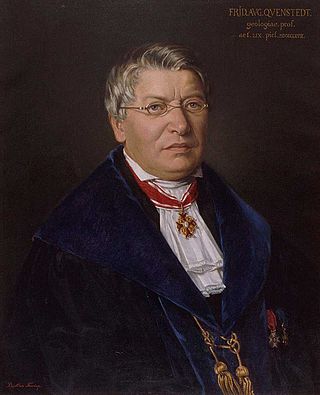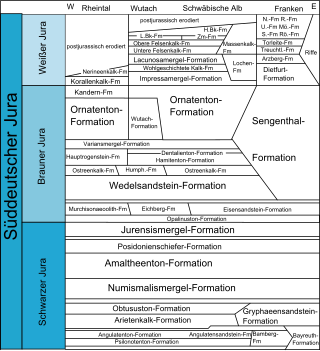
Friedrich August von Quenstedt was a German geologist and palaeontologist.

The Mindel glaciation is the third youngest glacial stage in the Alps. Its name was coined by Albrecht Penck and Eduard Brückner, who named it after the Swabian river, the Mindel. The Mindel glacial occurred in the Middle Pleistocene; it was preceded by the Haslach-Mindel interglacial and succeeded by the Mindel-Riss interglacial.

The Riss glaciation, Riss Glaciation, Riss ice age, Riss Ice Age, Riss glacial or Riss Glacial is the second youngest glaciation of the Pleistocene epoch in the traditional, quadripartite glacial classification of the Alps. The literature variously dates it to between about 300,000 to 130,000 years ago and 347,000 to 128,000 years ago. It coincides with the Saale glaciation of North Germany. The name goes back to Albrecht Penck and Eduard Brückner who named this cold period after the river Riss in Upper Swabia in their three-volume work Die Alpen im Eiszeitalter published between 1901 and 1909.

The term Albtrauf refers to the northwest facing escarpment of the Swabian Alps, situated in Baden-Württemberg and Bavaria. It is the most distinctive stepped slope within the alpine region of the South German Scarplands, leading roughly from the southwest to the northeast.
Gunz, Günz or Gunz Complex is a timespan in the glacial history of the Alps. It started approximately one million years ago and ended about 370 000 years ago. Some sources put the end at 480 000 years ago. Deep sea core samples have identified approximately 5 glacial cycles of varying intensity during Gunz.

The Trossingen Formation, formerly the Knollenmergel, is a geological formation in Germany and Switzerland. It dates back to the late Norian-Rhaetian.
The Lias Group or Lias is a lithostratigraphic unit found in a large area of western Europe, including the British Isles, the North Sea, the Low Countries and the north of Germany. It consists of marine limestones, shales, marls and clays.
The Buntsandstein or Bunter sandstone is a lithostratigraphic and allostratigraphic unit in the subsurface of large parts of west and central Europe. The Buntsandstein predominantly consists of sandstone layers of the Lower Triassic series and is one of three characteristic Triassic units, together with the Muschelkalk and Keuper that form the Germanic Trias Supergroup.

Eberhard Fraas was a German scientist, geologist and paleontologist. He worked as a curator at the Stuttgarter Naturaliensammlung and discovered the dinosaurs of the Tendaguru formation in then German East Africa. The dinosaur Efraasia is named after him.

The Nusplingen Limestone is a geological formation in Baden-Württemberg, Germany. It preserves fossils dating to the Kimmeridgian age of the Late Jurassic. It mainly consists of lithographic limestones deposited in a marine basin, similar to the Solnhofen Limestone. Fossils of pterosaurs, thalattosuchians, and the oldest geophilomorph centipede Eogeophilus were found in the Nusplingen Limestone.
The Haslach glaciation, Haslach Glacial Stage (Haslach-Glazial), Haslach Complex (Haslach-Komplex) and Haslach Ice Age (Haslach-Eiszeit) are historical terms for a cold period of the Pleistocene epoch. Haslach was not included in the traditional glacial schema of the Alps by Albrecht Penck and Eduard Brückner. The glacial stage was first described around 1981 by A. Schreiner and R. Ebel. Its type region is the Haslach Gravels (Haslach-Schotter) in the area of the Riss-Iller-Lech Plateau. The Haslach cold period was thought to be preceded by the Günz-Haslach interglacial and followed by the Haslach-Mindel Interglacial.

The Black Jurassic or Black Jura in earth history refers to the lowest of the three lithostratigraphic units of the South German Jurassic, the latter being understood not as a geographical, but a geological term in the sense of a lithostratigraphic super group. Formerly and even occasionally today in the popular scientific literature, this term is equated to the chronostratigraphic series of the Lower Jurassic. This is however not quite correct, because the Black Jura does not exactly coincide with the chronostratigraphic boundaries of the Lower Jurassic. In addition, the term lias, which was formerly frequently used as a synonym, should no longer be used in connexion with the South German Jurassic. Instead, the term lias, or North German Lias, should be reserved for the roughly equivalent lithostratigraphic unit in the North German Jurassic. The deposition of the Black Jurassic took place about 199 to 175 million years ago. The Black Jurassic follows the lithostratigraphic unit of the Keuper and is superimposed on the lithostratigraphic group of the Brown Jurassic.

The White Jurassic or White Jura in earth history refers to the upper of the three lithostratigraphic units of the South German Jurassic, the latter being understood not as a geographical, but a geological term in the sense of a lithostratigraphic super group. Formerly and even occasionally today in the popular scientific literature, this term is equated to the chronostratigraphic series of the Upper Jurassic. This is however not quite correct, because the White Jura does not exactly coincide with the chronostratigraphic boundaries of the Upper Jurassic. In addition, the term Malm, which was formerly frequently used as a synonym should no longer be used in connexion with the South German Jurassic. Instead the term "Malm" should be reserved for the roughly equivalent lithostratigraphic unit in the North German Jurassic. The White Jurassic was deposited about 161-150 million years ago. The White Jurassic follows the lithostratigraphic unit of the Brown Jurassic. Its upper boundary is erosive. Locally the White Jurassic is overlain with a large stratigraphic hiatus of the Regensburg Green Sandstone (Cenomanian).

The term South German Jurassic in earth history is used to refer to a lithostratigraphic rock unit at the hierarchical level of a super group. The rocks of the South German Jurassic were mainly deposited during the Jurassic period. The boundaries of the South German Jurassic and those of the chronostratigraphic or international Jurassic are not, however, exactly coincident. The depositions began rather later than the date of the international Triassic/Jurassic boundary and end as a result of erosion of the uppermost strata at various times during the Upper Jurassic, i.e. well before the international Jurassic/Cretaceous boundary. The rock unit of the South German Jurassic is underlain by Keuper; in between is a small stratigraphic hiatus. Above the South German Jurassic the beds follow discordantly and with a large stratigraphic gap; in addition, Regensburg Green Sandstone occurs very locally, which is dated to the Cenomanian stage of the Cretaceous period. In its southern fringes the South German Jurassic dives under the Palaeogene molasse depositions of the basement.

Oscar Friedrich von Fraas was a German clergyman, paleontologist and geologist. He was the father of geologist Eberhard Fraas (1862–1915).
The Gunz-Haslach interglacial and the Gunz-Haslach warm period (Günz-Haslach-Warmzeit) are historical terms for a hypothetical warm period of the Pleistocene in the Alpine region, between the Gunz and Haslach glaciations. The interglacial was defined as the erosion phase which follows the Günz and precedes the Haslach Glacial Stage. It thus corresponds to the stratigraphic gap between the Zeil gravels in Swabia and Haslach gravels northeast of the Rhine Glacier.
The Haslach-Mindel interglacial and the Haslach-Mindel warm period (Haslach-Mindel-Warmzeit) are historical terms for a hypothetical warm period of the Pleistocene in the Alpine region, between the Haslach and Mindel glacial stages. The interglacial was defined as the erosion phase which follows the Haslach and precedes the Mindel glacial stage. It thus corresponds to the stratigraphic gap between the Haslach beds and the Tannheim-Laupheim gravels northeast of the Rhine Glacier.

The geology of Germany is heavily influenced by several phases of orogeny in the Paleozoic and the Cenozoic, by sedimentation in shelf seas and epicontinental seas and on plains in the Permian and Mesozoic as well as by the Quaternary glaciations.
The Ornatenton Formation is a Jurassic marine formation in Germany that is middle Callovian in age. The formation represents a shallow marine environment.
Trematospondylus is a dubious genus of plesiosaurs from the Middle Jurassic of Baden-Württemberg, Germany. The only named species is Trematospondylus macrocephalus. It is one of the earliest scientifically described plesiosaurs and historically has been the first plesiosaur named from Germany. Preserved remains include seven vertebrae.









